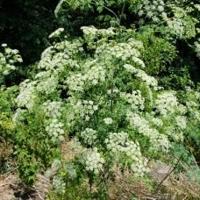
How to spot and control poison hemlock | Home & Garden
URBANA — Poison hemlock (Conium maculatum) has received a lot of attention lately, with reports of expanding populations statewide and subsequent increased human contact with this toxic plant. However, there is some confusion about the risk this plant poses to humans and animals, along with what measures should be taken for protection.
The wild carrot family (Apiaceae) has long been known to include plants with potentially harmful effects to humans. Many plants in this family, including poison hemlock, are dangerous or even deadly when consumed and many produce other defensive chemical compounds that have serious effects if we simply come in contact with plant parts.
Wild parsnip (Pastinaca sativa), another carrot family plant, is well known for its photo-reactive sap. Compounds in the sap, called furanocoumarins, cause a painful skin rash if sap contacts skin in the presence of sunlight. Every year, many folks are unknowingly exposed to this plant resulting in a mysterious rash. In my experience, it is the most common wild carrot family member to cause harm to humans.
The risk of rash development from contact with poison hemlock varies based on the health condition of the plants in question. It’s possible to be exposed to sap and not contract a rash, which has resulted in some confusion about whether or not poison hemlock has the ability to cause skin rashes.
YARD AND GARDEN: Master gardeners to hold workshop, pasture walk
Risk from ingestion of poison hemlock
The risk of death from ingestion of poison hemlock is not questioned, however. A different set of compounds produced by this plant, most notably coniine and a few other toxic alkaloids, cause rapid death in very small amounts if they enter the body through ingestion or other means.
This attribute has been somewhat sensationalized in recent years, drawing much media attention and creating a general panic surrounding exposure to poison hemlock. Not to say that precaution shouldn’t be taken around this noxious plant, but it’s highly unlikely that death can result simply from being in proximity of poison hemlock plants.
Poison hemlock is a non-native, invasive plant that is commonly observed along fence rows and edges of pastures, which poses a serious threat to grazing animals. If consumed, the plant is equally as lethal to livestock as it is to humans. However, it’s not a preferred forage plant and grazing animals will typically favor other plants of higher quality over poison hemlock. Nonetheless, quick action needs to be taken if this plant appears in or around grazing areas.
Where does poison hemlock occur in Illinois?
While poison hemlock is certainly widespread in rural areas, it’s less of a threat in more developed landscapes. The plant thrives on disturbance and primarily occupies degraded habitats.
It’s unlikely to pop up in your vegetable garden or landscaping.
It’s highly likely along highways, railroads, field edges, and other areas that are infrequently mowed.
How to control poison hemlock
Control of poison hemlock is a bit complicated because the plant, like many others in the carrot family, its biennial, meaning it grows for two years before setting seed and dying back. Control measures center on stopping seed production but vary based on the life stage of the plants.
At this point in the season, chemical control is not a great option since the plant has initiated flowering and may be getting close to seed set. However, it is an opportune time to hand pull or remove plants with a sharp shovel since plant resources are low due to the high investment required to flower and set seed. Use a sharp shovel to sever the tap root below the soil line. Or plants can be hand-pulled if soil moisture permits. Pulled or cut plants must be bagged and set to the landfill as seed production can still occur.
Mowing is a great option to stop or limit seed production if other measures cannot be taken. Repeated mowing can actually eliminate the plant if consistently applied over several growing seasons. However, be sure to mow before seed production begins or your mower may spread seed to new locations during future mowing.
My Town: Clint Walker’s memories of Coles County as pulled from the archives
Cosmic Blue Comics

From the Nov. 22, 1992, Journal Gazette, this photo of Cosmic Blue Comics in Mattoon; where I spent virtually every Saturday afternoon for about two years. That small back room you see just off to the right of the Coca-Cola sign was where they kept the many, and I mean many, long-boxes of back issues. I still own my bagged copy of “Tales of the Beanworld” issue No. 1 that I found back there. Sadly, this location is now just a “greenspace”.
Mattoon Arcade

Pictured, Shelbyville’s Bob Murray from the June 2, 1982, Journal Gazette, displaying his dominance over the TRON arcade game at the “Carousel Time” arcade at the Cross County Mall, later to be the Aladdin’s Castle, soon thereafter to be not a thing anymore. I spent just about every Saturday at that arcade, perhaps with that exact same haircut. No overalls, though. I was more of an “Ocean Pacific” kind of kid.
Icenogle’s

Pictured, from the Nov. 28, 1988, Journal Gazette, Icenogle’s grocery store. Being from Cooks Mills, we didn’t often shop at Icenogle’s…but when we did, even as a kid, I knew it was the way a grocery store is supposed to be in a perfect world, and that’s not just because they had wood floors, comic books on the magazine rack, or plenty, and I mean plenty, of trading cards in wax packs.
Cooks Mills

I had long since moved away from Cooks Mills by the time this Showcase item about Adam’s Groceries ran in the June 13, 1998, Journal Gazette, but there was a time when I very well could have been one of those kids in that photo; for if it was summer, and you had a bike, and you lived in Cooks Mills, that’s where you ended up. At last report, they still had Tab in the Pepsi-branded cooler in the back. I’m seriously considering asking my money guy if I could afford to reopen this place.
Mister Music

Pictured, from the July 16, 1987, Journal Gazette, this ad for Mister Music, formerly located in the Cross County Mall. I wasn’t buying records at that age, but I would eventually, and that’s where it all went down. If you don’t think it sounds “cool” to hang out at a record store with your buddies on a Friday night, a piping-hot driver’s license fresh in your wallet, you’d be right. But it’s the best a geek like me could do. Wherever you are today, owners of Mister Music, please know that a Minutemen album I found in your cheap bin changed my life.
Sound Source Guitar Throw

Portrait of the author as a young man, about to throw a guitar through a target at that year’s Sound Source Music Guitar Throwing Contest, from the April 18, 1994, Journal Gazette. Check out my grunge-era hoodie, and yes…look carefully, those are Air Jordans you see on my feet. Addendum: despite what the cutline says, I did not win a guitar.
Pictured, clipped from the online archives at JG-TC.com, a photo from the April 18, 1994, Journal Gazette of Sound Source Music Guitar Throwing Contest winner, and current JG-TC staff writer, Clint Walker.
Vette’s

Here today, gone tomorrow, Vette’s Teen Club, from the June 20, 1991, Journal Gazette. I wasn’t “cool” enough to hang out at Vette’s back in it’s “heyday,” and by “cool enough” I mean, “not proficient enough in parking lot fights.” If only I could get a crack at it now.
FutureGen

FutureGen: The end of the beginning, and eventually, the beginning of the end, from the Dec. 19, 2007, JG-TC. I wish I had been paying more attention at the time. I probably should have been reading the newspaper.
